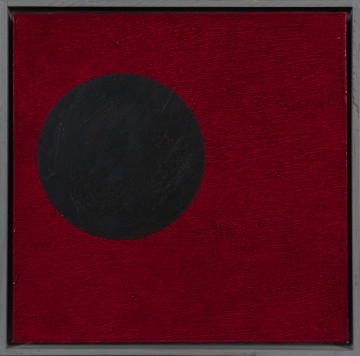
Stettin I | Szczecin I
1930
National Museum in Szczecin
Part of the collection: European classics of modernity
Friedrich Bernhardt (1894–1986) received his artistic education in Bruges (Belgium) and Berlin (Germany). From 1922, he worked at the Friedrich Schiller Realschule in Szczecin, and shortly after, at the Otto von Bismarck Realschule. His artistic maturity was significantly shaped by his participation in expressionist Johannes Itten’s courses in 1928 and 1929, organised for students and supporters of the Szczecin School of Arts and Crafts. His connections with Bauhaus graduates Kurt Schwerdtfeger and Elsa Mögelin, as well as with the institution's director, architect Gregor Rosenbauer, and art historian Walter Riezler – director of the Municipal Museum and a Werkbund theorist – further reinforced the constructivist influences in Bernhardt’s work.
The interior view of a staircase from this period, featuring four – or rather five – figures captured in a fleeting, fragmented manner, reflects Bernhardt’s synthesis of geometric abstraction with his ongoing fascination with the human body as part of the broader universe. His interest in the nude form, as well as in the ideas of modern dance and gymnastics, was sparked by his early encounters with the avant-garde environment of the Jacques-Dalcroze School of Rhythmic Gymnastics in Hellerau near Dresden during his student years. These inspirations are particularly evident in his 1921 graphic works, such as Dancer Mary Wigman, Place of Worship, Day, Night, and posters for the Gottfried Haaß-Berkow Theatre (1921) and Herbert Kaethner’s Gymnastics Courses (1925), all imbued with the mystical aesthetics of Fidus and the theosophy of Rudolf Steiner.
The composition, featuring a nude youth alongside figures dressed in gymnastic attire and holding sports-related props, recalls Bauhaus Stairway by Oskar Schlemmer (1888–1943). Although the most famous version of this theme, housed at the Museum of Modern Art in New York, was created a year after Bernhardt's painting, Schlemmer had been exploring similar depictions of human figures in architectural settings since 1925. During the same period, Else Mögelin translated the motif of the body’s relationship with geometric space into the medium of textiles in her work People (c. 1930).
Szymon Piotr Kubiak
Author / creator
Object type
painting
Technique
oil technique
Material
canvas
Origin / acquisition method
donation
Creation time / dating
Creation / finding place
Owner
The National Museum in Szczecin
Identification number
Location / status

1930
National Museum in Szczecin

2008
National Museum in Szczecin

1994
National Museum in Szczecin
DISCOVER this TOPIC
Museum of King Jan III's Palace at Wilanów
DISCOVER this PATH
Educational path